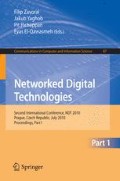Abstract
Chatbot is one of a technology that tried to encounter the question that popped into computer science field in 1950 which is “Can machines think?” [6]. Proposed by mathematician Alan Turing, the question later becomes the pinnacle reference for researchers in artificial intelligence discipline. Turing later also introduces “The Imitation Game” that now known as “Turing Test” where the idea of the test is to examine whether machine can fool a judge into thinking that they are having a conversation with an actual human. The technology back then was great but in rapid evolution of computer science, it can become even better. Evolution is computer scripting language, application design model, and so on, clearly have its advantage towards enabling more complex features in developing a computer program. In this paper, we propose an enhanced algorithm of a chatbot by taking advantages of relational database model to design the whole chatbot architecture that enable several features that cannot or difficult to be done in previous state of computer science programming technique. Started with some literature of a previous developed chatbot, then a detailed description of each new enhanced algorithm together with testing and results from the implementation of these new algorithms that can be used in development of a modern chatbot. These several new algorithms will enable features that will extend chatbot capabilities in responding to the conversation. These algorithm is actually implemented in design and development of chatbot that specifically deal with Bahasa Malaysia language, but taking to account that language in chatbot is really about the data in chatbot knowledge-based, the algorithm is seems transferable wherever it fits into another human language.
Access this chapter
Tax calculation will be finalised at checkout
Purchases are for personal use only
Preview
Unable to display preview. Download preview PDF.
References
Sawar, A., Atwell: Chatbots: are they really useful? LDV-Forum Band 22(1), 31–50 (2007)
Caplan, D., Waters, G.: Verbal working memory and sentence comprehension. Behavioral and brain Sciences 22, 77–126 (1999)
Gibson, E.: Linguistic complexity: locality of syntactic dependencies. Cognition 68, 1–76 (1998)
King, J., Just, A.: Individual differences in syntactic processing: the role of working memory. Journal of Memory and Language 30, 580–602 (1991)
Crocker, M.W., Pickering, M., Clifton Jr., C. (eds.): Architectures and Mechanisms for Language Processing. Cambridge University Press, Cambridge (2000)
Turing, A.M.: Computing Machinery & Intelligence. Mind LIX(236) (1950)
Wallace, R.: AIML Pattern Matching Simplified, http://alicebot.org
Webber, G.M.: Data Representation and Algorithms For Biomedical Informatics Applications, PhD thesis, Harvard University (2005)
Weizenbaum, J.: ELIZA- A Computer Program For the Study of Natural Language Communication Between Man And Machine. Communication of the ACM 9(1) (1966)
Shah, H.: A.L.I.C.E.: an ACE in Digitaland. TripleC 4(2), 284–292 (2006)
Author information
Authors and Affiliations
Editor information
Editors and Affiliations
Rights and permissions
Copyright information
© 2010 Springer-Verlag Berlin Heidelberg
About this paper
Cite this paper
Lokman, A.S., Zain, J.M. (2010). Chatbot Enhanced Algorithms: A Case Study on Implementation in Bahasa Malaysia Human Language. In: Zavoral, F., Yaghob, J., Pichappan, P., El-Qawasmeh, E. (eds) Networked Digital Technologies. NDT 2010. Communications in Computer and Information Science, vol 87. Springer, Berlin, Heidelberg. https://doi.org/10.1007/978-3-642-14292-5_5
Download citation
DOI: https://doi.org/10.1007/978-3-642-14292-5_5
Publisher Name: Springer, Berlin, Heidelberg
Print ISBN: 978-3-642-14291-8
Online ISBN: 978-3-642-14292-5
eBook Packages: Computer ScienceComputer Science (R0)

